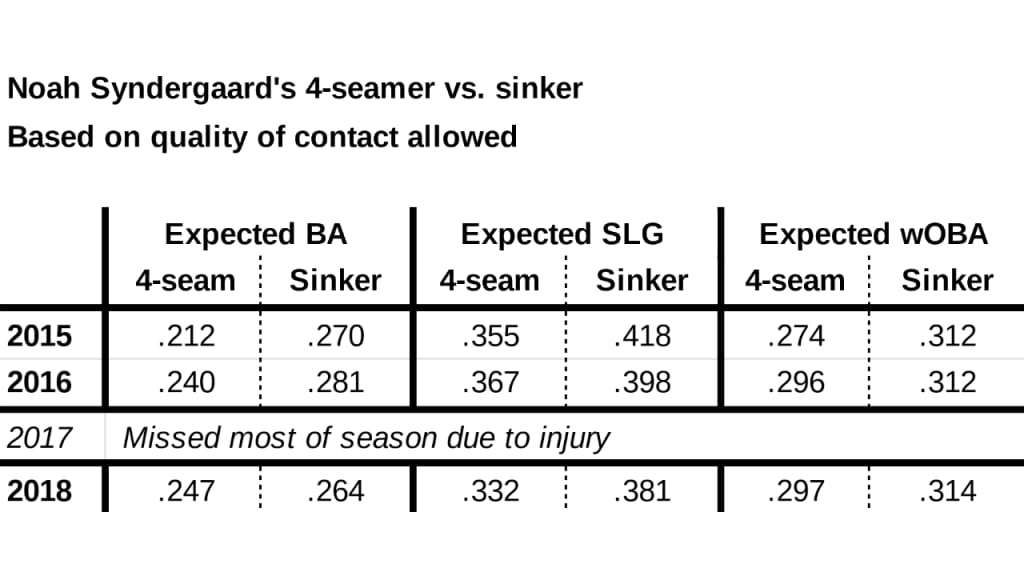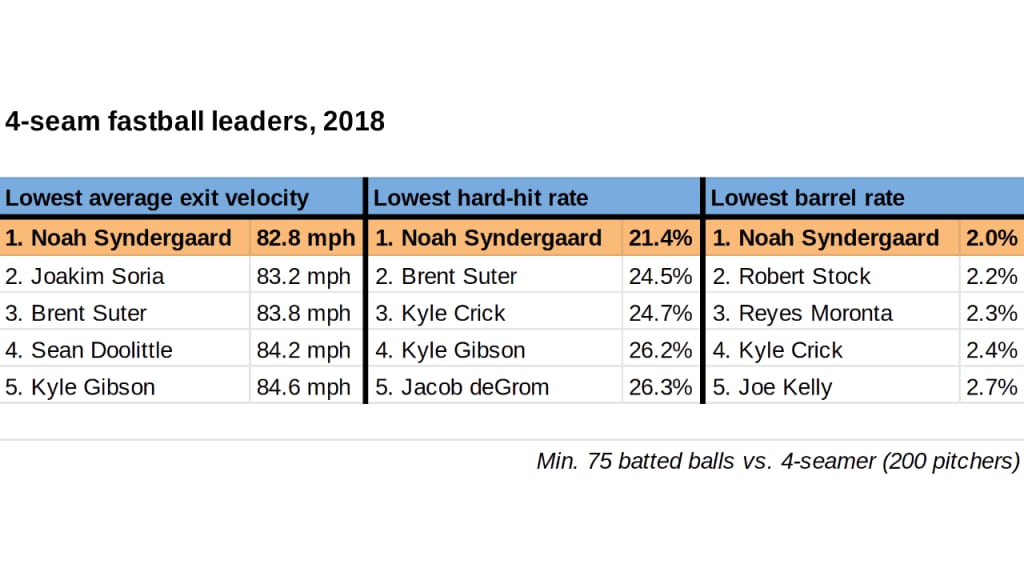
Noah Syndergaard is trying to join the wave of high-fastball adopters. But should he?
Last week, the most interesting tidbit to come out of Thor's Spring Training debut was that he's planning to table his sinker -- which he called an "artsy pitch" -- in favor of four-seamers, which he can elevate. Syndergaard had been using his sinker as his primary fastball, throwing it 32.8 percent of the time in 2018, compared to 20.7 percent for four-seamers.
This would be the same change pitchers like Justin Verlander and Gerrit Cole have implemented to huge success with the Astros, and the same approach Mets ace Jacob deGrom has shifted toward. But not all fastballs are made for pitching up. As Verlander puts it, you have to have "hop." Even a pitcher with Syndergaard's extreme velocity shouldn't necessarily go all-in on elevated four-seamers.
And in Thor's case, it's not so clear. There are data that support throwing four-seamers, and data that support maintaining his sinker. Let's break it down.
The case for Syndergaard's four-seamer
Overall, Syndergaard's four-seamer has gotten better results than his sinker. He has suppressed hitters' contact more successfully.
Statcast generates a set of expected metrics based on a pitcher's quality of contact allowed: expected batting average, expected slugging percentage and the holistic expected wOBA. Syndergaard's four-seamer has consistently outperformed his sinker in those expected stats.

Last season in particular, Syndergaard's four-seamer got softer contact. The average exit velocity against his sinker was 87.9 mph; against his four-seamer, it was 82.8 mph. His hard-hit rate allowed on sinkers was 36.7 percent; on four-seamers, it was 21.4 percent. And just 2.0 percent of the batted balls against his four-seamer qualified as barrels -- hits with optimal exit velocity and launch angle -- compared to 3.6 percent against his sinker.
There were 200 pitchers with at least 75 batted balls against their four-seamers in 2018. Syndergaard ranked No. 1 in average exit velocity, hard-hit rate and barrel rate.

That certainly lends support to the idea that he should use it more often. But there's also an important, narrower purpose in throwing high four-seamers: Getting swings-and-misses and strikeouts. And that's where things get more complicated.
The case for Syndergaard's sinker
One specific type of four-seamer plays best up in the zone: a high-spin four-seamer. High spin rate on a fastball gives it the rise effect that leads to whiffs, especially when elevated.
Verlander, for example, led all starters with an average four-seam spin rate of 2,618 rpm last season. League-average four-seam spin rate for starting pitchers was 2,245 rpm. And Syndergaard averaged just 2,170 rpm. When you adjust for his high velocity, that low spin stands out even more.
Thor's ratio of four-seam spin rate to velocity -- a number termed Bauer Units by Driveline Baseball -- is one of the lowest among starting pitchers. Again, looking at Verlander as a foil, the Astros ace has one of the highest spin-to-velocity marks. That combination is what makes his high fastball so good.
Of the 215 starting pitchers who threw at least 100 four-seamers last season, Verlander ranked third in Bauer Units. Syndergaard ranked 195th.
Syndergaard vs. Verlander, four-seamer Bauer Units
Verlander: 2,618 rpm / 95.0 mph = 27.6 Bauer Units
MLB avg. SP: 2,245 rpm / 92.7 mph = 24.2 Bauer Units
Syndergaard: 2,170 rpm / 97.6 mph = 22.2 Bauer Units
Syndergaard's four-seamer, despite being one of the fastest in the game, doesn't get a ton of swings-and-misses. Its low spin could be the reason.
Hitters only whiffed on 14.5 percent of their swings against his four-seamer last season, well below league average (20.5 percent) and less than half the whiff rate of high-fastball experts like Verlander (29.3 percent), Cole (29.7 percent), Max Scherzer (30.4 percent) and deGrom (31.9 percent). Even in 2015 and '16, Syndergaard's best swing-and-miss seasons with his four-seamer, his whiff rates were only 22.9 percent and 21.6 percent, respectively.
But there is something low-spin fastballs are good for: Getting ground balls. So it might make more sense for Syndergaard to channel his efforts into his sinker, which is, of course, the chief ground-ball pitch type.
Syndergaard had a 56.2 percent ground-ball rate with his sinker last season, compared to 38.8 percent with his four-seamer. In his career, his sinker has generated a ground-ball rate of about 60 percent, ranking within the top 15 percent of starting pitchers since 2015 in that regard.
The bottom line
For Syndergaard, there could be a place for both four-seamers and sinkers.
Maybe he wants to emphasize four-seamers this year. That's fine -- it's been the more effective pitch type for him overall, and if he commits himself to elevating more often than he has, more swings-and-misses might come in 2019.
But his fastball profile also lends itself to sinkers. Even if strikeouts are best, ground balls have value for a pitcher. Just ask any good launch-angle revolutionary -- like Justin Turner, who once said, "You can’t slug by hitting balls on the ground," or Daniel Murphy, who calls ground balls "seven-percenters," based on how often they go for extra-base hits.
Syndergaard's sinker gets ground balls, and that should prove useful in plenty of situations over the course of a season. It might be artsy, but it's probably not a pitch he should send to the scrap heap.


